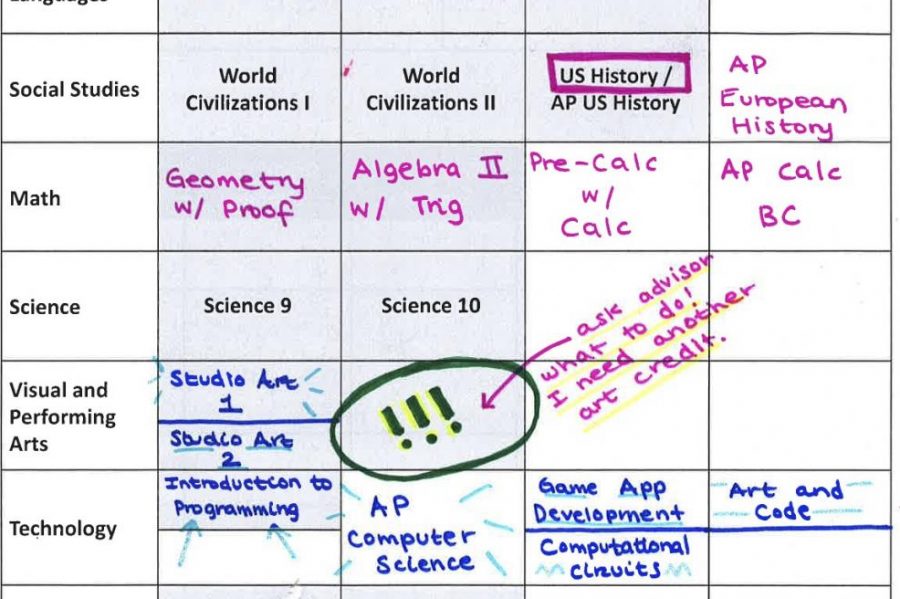In order to graduate, students must earn adequate credits for certain subjects. As a school that provides a liberal arts education, ASL requires credits for core subjects like Science, Math, English, Social Studies, and World Language, but also electives. The current graduation requirements for electives are four semesters worth of arts credits and one semester worth of technology.
To Computer Science Teacher Kent Collins, spending a semester out of one’s whole high school career fulfilling a technology credit reflects being prepared for “the world that existed in 2000.”
Collins believes that the world has changed so much from a technology standpoint that students don’t have enough experience with it with the required technology credit “Since [2000], the world has made a lot of progress with technology, which is not captured in that technology credit,” he said. “When we look at the 21st century and how humans interact, we’re not addressing fundamental knowledge that our students need in order to thrive and be successful.”
Specifically, Collins highlights students lack of awareness in how technology impacts the world on a macro level. “The required credit doesn’t have any expectation that students think through the ethical considerations of computing, how ‘big’ data is being used, how social networks impact our world, or how algorithms are used in modern society to drive the world around us,” he said.
Similarly, High School Principal Devan Ganeshananthan believes that the structure of the graduation requirements and the “way requirements are illustrated in different areas, is perhaps something we should consider if it’s outdated… Right now the way [the graduation requirements] set out is it communicates to students that art is more important than technology,” he said.
For Sofia Michaelides (’22), a particularly STEM-focused student, the imbalance between technology and art makes it harder for her to complete her required credits. “It’s more difficult for people who are not interested in art to get their credits done, and having to spend more time completing classes that one doesn’t have interest in can be frustrating,” she said.
There is expected to be a credit review in upcoming years, and Ganeshananthan said that when taking their next look at ASL’s graduation requirements, the administration will take a look at the statistics of the student’s amount of credits in both technology and art. “We try to see if students are steered by graduation requirements or not, and what direction the school should be going about,” he said. “We want students to be exiting with experiences, with feelings, with some kind of ‘capstone’ experience that perhaps they have an interest in.”
Due to Alice Moyle’s (’20) passion for art, the imbalance between technology and art was something that had never crossed her mind during her high school career. She filled her technology credit during her freshman year by taking Digital Photography – a class that counts for either art or technology, depending on the preference of the student.
Though, Collins challenges the idea of meshing certain art classes as a technology credit. “If looking at a digital photography class, it involves no expectation that a student will learn about the essential technological challenges that students are facing,” he said.
In contrast, Ganeshananthan feels that in the past decade, art and technology have evolved to “mesh” together. Therefore, the idea of connecting art to technology is appropriate for certain classes.
Moreover, Michaelides believes both art and technology should have the same number of required credits. “It would be easier if the requirements were the same, because it makes it more equal, depending on your interests,” she said, “I think ASL could do a better job of balancing out their credits.”
Although some students may feel the credits don’t suit their interest, Ganeshananthan said that the imbalance of technology and art requirements, or any requirements for that matter, cannot be changed in the blink of an eye. When the administration thinks about how to evolve the requirements, certain constraints come into play. “We have to take a look at what regulations are already in place, then think about what colleges and universities may be looking for,” he said. “That’s really interesting to try and contemplate.”
Nevertheless, Collins believes that increasing the technology credit would be very beneficial for student’s futures. “Reframing [the technology credit] to focus on the instructive, creative, educational use of technology rather than just using apps, might be a good way to give it some renewed vigor and make sure it’s preparing our students to succeed beyond ASL,” he said.






